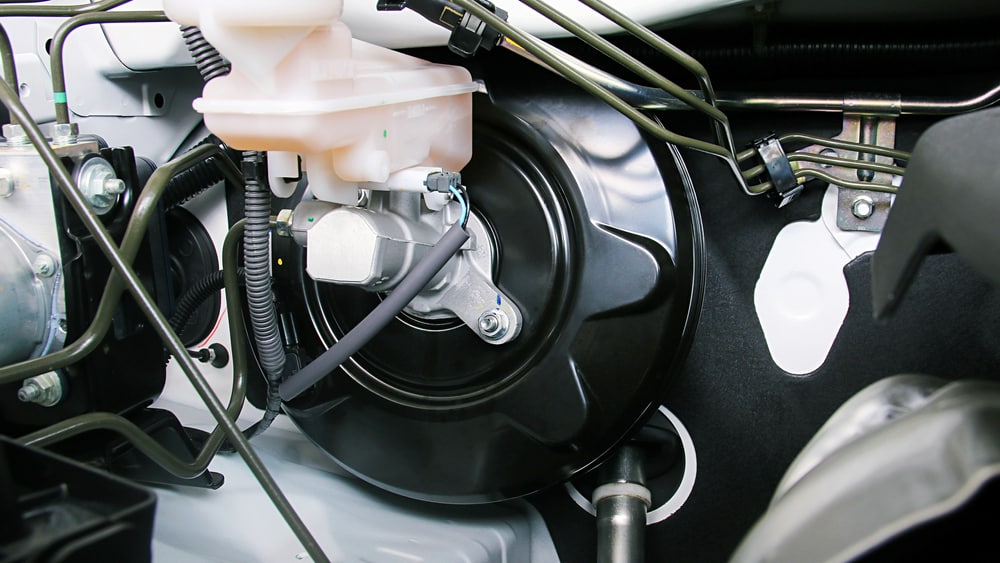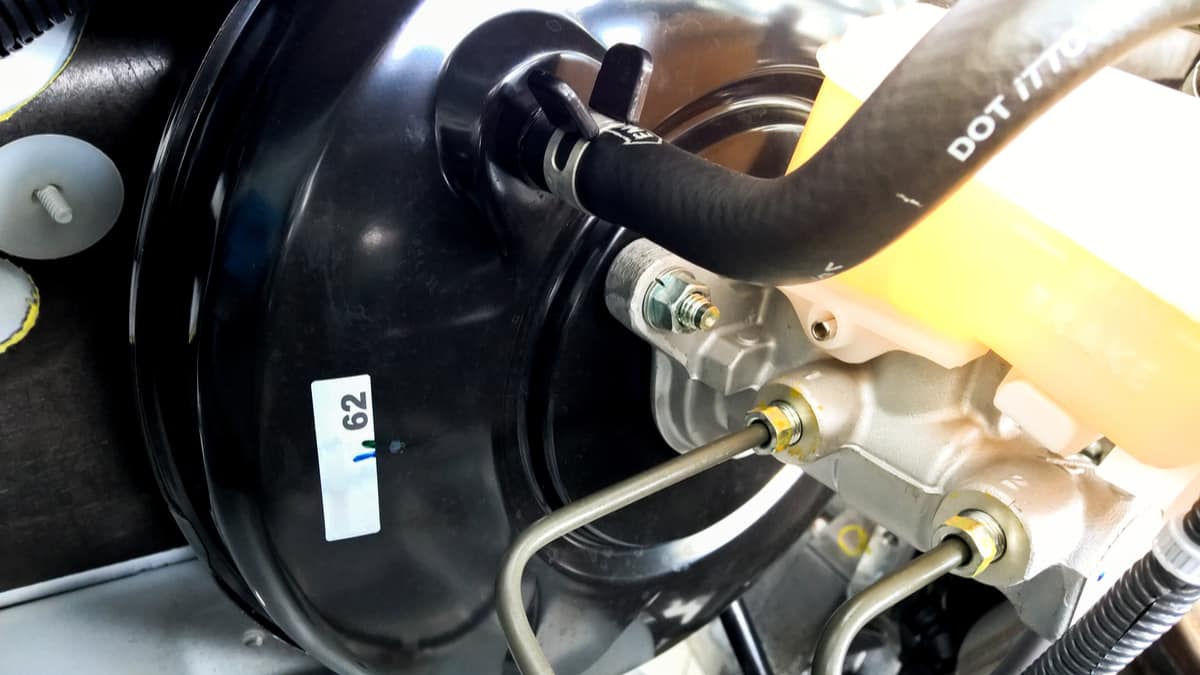Your car’s braking system is made up of many components working together in harmony to stop the vehicle when you press on the pedal. If one part fails, the entire system is compromised. This couldn’t be more evident than when you experience a bad vacuum brake booster.
I look at the top symptoms of a bad vacuum brake booster and discuss its function. I also evaluate the replacement cost of a vacuum brake booster and determine if it’s safe to drive when this part fails. Let’s begin with a quick look at the signs, first.
Symptoms Of A Bad Vacuum Brake Booster
The most common symptoms of a bad brake booster are a stiff brake pedal and increased stopping distance. You can sometimes also hear a hissing noise coming from the engine at idle. A warning light on the dashboard could also show up.
Here is a more detailed list of the signs of a bad or failing brake booster to look for:
1. Stiff Brake Pedal

When you attempt to brake your car, you shouldn’t have to exert a lot of pressure. This holds true except for when the vacuum brake booster goes bad.
When this vital component fails, you will lose your braking assist. To get the vehicle to stop, you will have to put a lot of pressure on the brake pedal.
2. Increased Stopping Distance

Most drivers have a good feel for how long it takes to stop the vehicle. If this time appears to be getting longer, something might be wrong.
When braking assist functionality is lost, you need to exert a lot more force to stop the car. This increased stopping distance might happen all of a sudden or more subtley over time, depending on how quickly the part fails.
3. Hissing Noise

Brakes can make a variety of noises, from squealing to grinding, none of which are good. A failing vacuum brake booster will make a distinct hissing noise.
When the vacuum-operated brake booster begins to leak, air escapes from the diaphragm or housing. This rush of air leads to a hissing sound that is most prominent when applying the brakes.
4. Dashboard Warning Lights

Your modern vehicle is set up with a multitude of sensors, alerting you when a problem occurs. The anti-lock braking system is no different.
If you get an ABS warning on your dashboard, it could be a sign that something is wrong with the vacuum brake booster. Not only will your braking ability be affected, but you might also have issues with the traction and stability control systems, which have their own warning lights.
Vacuum Brake Booster Function

The brake booster aids the driver when braking a vehicle. It drastically reduces the effort required by applying force to the master cylinder. The master cylinder is responsible for distributing fluid to the brakes for proper operation.
There are three brake booster designs, with vacuum-operated being the most popular. However, some vehicles use a hydro-boost or electronic assembly model instead.
In the vacuum brake booster, the internal diaphragm separates the two different sides. These compartments are referred to as the working chamber and vacuum chamber. As the brakes get released, you will find an equal amount of vacuum on both sides. However, when you apply the brake pedal, a control valve permits more pressure into the working chamber. The result of this operation is the activation of a pushrod that applies force to the master cylinder, thereby allowing brake assist to aid the driver’s efforts.
Vacuum Brake Booster Location

The vacuum brake booster is located between the firewall and the brake master cylinder. To replace the booster, you will need to remove the master cylinder as well. That’s why many people choose to replace both parts at the same time.
The brake booster check valve can be found directly on the brake booster. If it isn’t there, it might be on the vacuum hose. However, some of these check valves are built directly into the vacuum hose and are, therefore, not serviceable. If the check valve has gone bad, you might need to replace the vacuum hose assembly.
Vacuum Brake Booster Replacement Cost
The average vacuum brake booster replacement cost is between $300 and $700, depending on the car model and labor costs. Labor will run between $100 and $200, while the parts are typically more than $150.
However, there are several factors that affect how much you will pay, including what kind of vehicle you drive, how difficult it is to get to the brake booster, and what other parts need to be replaced.
Most vacuum brake boosters will last 150,000 miles or more, rarely going bad. However, vehicles that operate in dry climates might face more dry rot, which can lead to premature deterioration of the vacuum brake booster diaphragm and cause failure.
If the vacuum brake booster fails, you should not continue driving your vehicle. In fact, you should never drive with any indication that something is wrong with your braking system. If your brakes are harder to operate and you are having difficulty stopping your vehicle, it’s time to have the system inspected by a qualified mechanic.
Is it safe to drive with a bad brake booster?
No. It is not safe to drive with a bad brake booster. Cars made to have a brake booster will be very difficult to stop from higher speeds, because the brake pedal will be very stiff without the brake booster.
Can a brake booster cause a soft pedal?
Most often, a bad brake booster will cause a stiff brake pedal, but if there is an internal problem, it could potentially cause a soft pedal. When your brake pedal is soft, however, it’s more common that a brake fluid leak or a bad master cylinder is at fault.
Can you repair a brake booster?
Whether or not you can repair a brake booster depends on the problem. If it is a gasket that needs replacing, you can repair it if you find a gasket. The problem is finding spare parts for it, because manufacturers usually sell the brake booster as a whole unit.
How long does a brake booster last?
The brake booster is made to last the entire life of a car, and it is not very common for it to break in most car models. However, some car models have a lower-quality brake booster, and you may need to replace it once or twice during the life of the car
Categories: Brakes

















